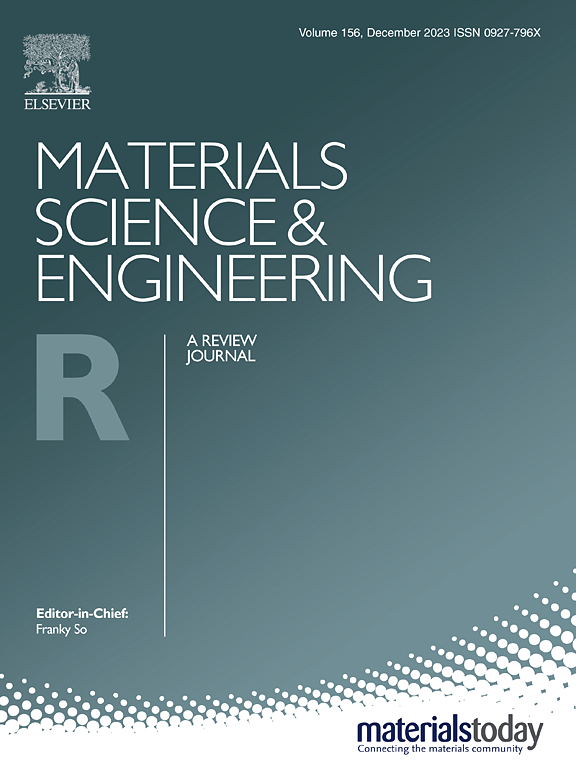Unveiling the potential of flexible perovskite photovoltaics: From lab to fab
IF 31.6
1区 材料科学
Q1 MATERIALS SCIENCE, MULTIDISCIPLINARY
引用次数: 0
Abstract
Flexible perovskite-based single-junction and tandem solar cells have achieved power conversion efficiencies (PCEs) exceeding 25% and 29%, respectively, and are regarded as ideal for portable and wearable optoelectronic devices, including building-integrated photovoltaic (BIPVs) applications, compared to other thin-film technologies and mainstream silicon. This is because perovskite films can be prepared using a low-temperature process and solution-based roll-to-roll fabrication with a superior power-to-weight ratio and high cost-effectiveness. Despite these advancements, the commercialization of f-PSCs remains constrained by several challenges associated with each sandwiched layer stacked in the device configuration, including the perovskite active layer, charge-transport layers (CTLs), flexible substrates, and electrodes. The delicate crystallization of perovskites on flexible substrates typically results in inhomogeneous nucleation and unwanted defect formation in perovskite films. Furthermore, the polycrystalline nature of perovskite films with numerous grain boundaries induces degradation sites and increases the susceptibility to mechanical fracture. Furthermore, CTLs at perovskite film interfaces encounter challenges such as weak adhesion, chemical instability, energetic alignment mismatches, and residual stress or strain. In addition, the top and bottom electrodes, including flexible substrates, remain susceptible to cracking and delamination under mechanical stress and real-world operating conditions. Consequently, f-PSCs exhibit fragility, reduced operational stability, and lower PCE than their rigid counterparts. These limitations present significant barriers to the industrial-scale production and commercialization of f-PSCs. In this review, we comprehensively discuss the existing challenges and progress regarding the material design of flexible devices based on the state-of-the-art results of single- and multijunction-based flexible perovskite devices. This involves flexible substrates and transparent electrodes, perovskite crystallization growth at low temperatures, synthesis of suitable CTLs, and interface passivation engineering to enhance performance and mechanical stability. Furthermore, we discuss large-scale production techniques, future prospects of flexible perovskite modules and encapsulation design, and the existing market potential to highlight the potential of f-PSCs for wearable and self-powered electronic devices in modern energy-harvesting technology. Finally, we also highlight the flexible perovskite recycling strategies prior to commercialization and emphasize a low carbon footprint and minimal environmental impact.
揭示柔性钙钛矿光伏电池的潜力:从实验室到工厂
柔性钙钛矿基单结和串联太阳能电池的功率转换效率(pce)分别超过25%和29%,与其他薄膜技术和主流硅相比,被认为是便携式和可穿戴光电设备的理想选择,包括建筑集成光伏(bipv)应用。这是因为钙钛矿薄膜可以使用低温工艺和基于溶液的卷对卷制造来制备,具有优越的功率重量比和高成本效益。尽管取得了这些进步,但f- psc的商业化仍然受到与堆叠在器件配置中的每个夹层层相关的几个挑战的限制,包括钙钛矿活性层、电荷传输层(ctl)、柔性衬底和电极。钙钛矿在柔性衬底上的精细结晶通常导致不均匀成核和钙钛矿薄膜中不必要的缺陷形成。此外,具有众多晶界的钙钛矿薄膜的多晶性质诱导了降解位点,增加了机械断裂的易感性。此外,钙钛矿膜界面上的ctl面临着粘附力弱、化学不稳定性、能量排列不匹配以及残余应力或应变等挑战。此外,顶部和底部电极,包括柔性衬底,在机械应力和实际操作条件下仍然容易开裂和分层。因此,与刚性材料相比,f- psc表现出脆弱性、操作稳定性和较低的PCE。这些限制对f- psc的工业规模生产和商业化构成了重大障碍。在这篇综述中,我们基于单结和多结柔性钙钛矿器件的最新成果,全面讨论了柔性器件材料设计方面存在的挑战和进展。这包括柔性衬底和透明电极,钙钛矿结晶生长在低温下,合成合适的ctl,界面钝化工程,以提高性能和机械稳定性。此外,我们讨论了大规模生产技术,柔性钙钛矿模块和封装设计的未来前景,以及现有的市场潜力,以突出f-PSCs在现代能量收集技术中用于可穿戴和自供电电子设备的潜力。最后,我们还强调了商业化之前的柔性钙钛矿回收策略,并强调低碳足迹和最小的环境影响。
本文章由计算机程序翻译,如有差异,请以英文原文为准。
求助全文
约1分钟内获得全文
求助全文
来源期刊

Materials Science and Engineering: R: Reports
工程技术-材料科学:综合
CiteScore
60.50
自引率
0.30%
发文量
19
审稿时长
34 days
期刊介绍:
Materials Science & Engineering R: Reports is a journal that covers a wide range of topics in the field of materials science and engineering. It publishes both experimental and theoretical research papers, providing background information and critical assessments on various topics. The journal aims to publish high-quality and novel research papers and reviews.
The subject areas covered by the journal include Materials Science (General), Electronic Materials, Optical Materials, and Magnetic Materials. In addition to regular issues, the journal also publishes special issues on key themes in the field of materials science, including Energy Materials, Materials for Health, Materials Discovery, Innovation for High Value Manufacturing, and Sustainable Materials development.
 求助内容:
求助内容: 应助结果提醒方式:
应助结果提醒方式:


